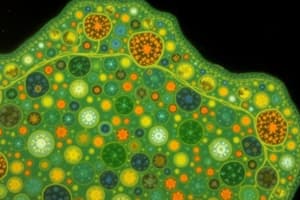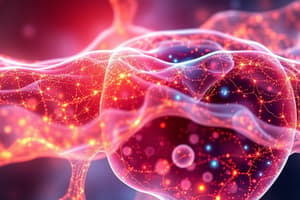Podcast
Questions and Answers
What are the two main types of membrane proteins and their respective roles?
What are the two main types of membrane proteins and their respective roles?
- Integral proteins phosphorylate substrates, while peripheral proteins transport nutrients.
- Integral proteins assist in signaling, while peripheral proteins serve as channels.
- Integral proteins span the membrane, while peripheral proteins are on the surface. (correct)
- Integral proteins facilitate transport, while peripheral proteins provide energy.
Which characteristic best describes the phospholipid bilayer's arrangement?
Which characteristic best describes the phospholipid bilayer's arrangement?
- Hydrophilic heads facing outward and hydrophobic tails inward. (correct)
- Hydrophilic heads facing inward and hydrophobic tails outward.
- Hydrophobic heads and tails interspersed randomly within the layer.
- Hydrophobic heads facing outward and hydrophilic tails inward.
What role do membrane carbohydrates primarily serve?
What role do membrane carbohydrates primarily serve?
- They facilitate the transport of ions across the membrane.
- They act as enzymes in metabolic pathways.
- They provide structural support to the plasma membrane.
- They contribute to cell-cell recognition and signaling. (correct)
Which types of molecules generally pass through the plasma membrane easily?
Which types of molecules generally pass through the plasma membrane easily?
Which statement about the fluid mosaic model is accurate?
Which statement about the fluid mosaic model is accurate?
Flashcards are hidden until you start studying
Study Notes
Fluid Mosaic Model
- Describes the structure of the plasma membrane.
- Composed of a phospholipid bilayer with embedded proteins.
- Lipids and proteins move laterally within the layer, resembling a mosaic.
- Provides fluidity, allowing for flexibility and dynamic interactions.
- Proteins can be integral (spanning the membrane) or peripheral (attached to the surface).
Selective Permeability
- The plasma membrane selectively allows substances to enter or exit.
- Small, nonpolar molecules (e.g., oxygen, carbon dioxide) can easily pass through.
- Ions and polar molecules require transport proteins to cross the membrane.
- Maintains homeostasis by regulating ion concentrations and nutrient uptake.
Membrane Proteins
- Serve various functions including transport, signaling, and structural support.
- Two main types:
- Integral proteins: Penetrate the lipid bilayer, facilitating transport and acting as channels or carriers.
- Peripheral proteins: Located on the membrane surface, involved in signaling and maintaining cell shape.
- Function as enzymes, receptors, and anchors for the cytoskeleton.
Phospholipid Bilayer
- Composed of phospholipids with a hydrophilic (water-attracting) head and two hydrophobic (water-repelling) tails.
- Arranged with heads facing outward (towards water) and tails inward (away from water).
- Creates a semi-permeable barrier that separates the internal environment of the cell from the external environment.
- Essential for compartmentalization and cellular function.
Membrane Carbohydrates
- Often attached to proteins (glycoproteins) or lipids (glycolipids) on the extracellular surface.
- Play crucial roles in cell-cell recognition, signaling, and adhesion.
- Involved in immune responses and as receptors for pathogens.
- Contribute to the glycocalyx, a protective and sticky layer around the cell.
Fluid Mosaic Model
- The plasma membrane is made of a phospholipid bilayer where proteins are embedded
- These components can move laterally, resembling a mosaic, providing flexibility and fluidity
- Proteins can be integral, spanning the membrane, or peripheral, attached to the surface
Selective Permeability
- The membrane allows certain substances to pass through but restricts others
- Small, nonpolar molecules like oxygen and carbon dioxide can pass easily
- Ions and polar molecules need transport proteins to cross
- This selective permeability regulates ion concentrations and nutrient uptake, maintaining homeostasis
Membrane Proteins
- Important for transport, signaling, and structural support
- Integral proteins cross the lipid bilayer and act as channels or carriers for transport
- Peripheral proteins are on the surface, involved in signaling and cell shape maintenance
- Proteins can function as enzymes, receptors, and anchors for the cytoskeleton
Phospholipid Bilayer
- Made of phospholipids with a hydrophilic head and two hydrophobic tails
- The heads face outward towards water while the tails face inward, away from water
- Creates a semi-permeable barrier that separates the cell's internal and external environments
- Essential for compartmentalization and cellular function
Membrane Carbohydrates
- Attached to proteins (glycoproteins) or lipids (glycolipids) on the outer surface
- Crucial for cell-cell recognition, signaling, and adhesion
- Involved in immune responses and acting as receptors for pathogens
- Contribute to the glycocalyx, a protective and sticky layer around the cell
Studying That Suits You
Use AI to generate personalized quizzes and flashcards to suit your learning preferences.




